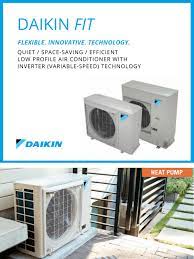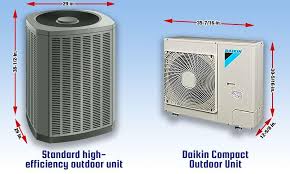
During cold winter months
- Account Managers
- November 11, 2022
- 1:39 pm
Don’t be misled by the name. When combined with an air handler, a heat pump is an ideal option for both heating and cooling your house. Consider a heat pump to be a heat transporter, sucking warm air from your house in the summer and bringing warm air in during the winter. Though it may be difficult to think that there is enough warmth in the outer air to heat your house throughout the winter, Daikin systems can supply heat at temperatures as low as -13 degrees Fahrenheit to keep you warm and cozy inside. An additional heat source may be necessary for much colder areas.
A heat pump and air handler system is a year-round home comfort option that is especially successful in mild to warmer sections of the country, and it performs an excellent job of keeping suitable indoor temperatures and humidity levels. Because air is drawn through an air filter, it also provides the air filtering benefits inherent in forced-air systems. This eliminates airborne particles and allows cleaner, filtered air to be dispersed throughout your house via air supply ducting.

A heat pump is an electrically powered device that takes heat from a lower-temperature source and transfers it to a higher temperature destination (a sink). The temperature of a source decreases as energy is removed from it. Thermal energy will be withdrawn from this space if the residence is employed as the source. This is how a heat pump works in cooling mode, and it is also how air conditioners and refrigerators work. Similarly, adding energy to a sink raises its temperature. If the house is utilized as a sink, thermal energy is added, which heats the room. A heat pump is totally reversible, which means it can heat and cool your home all year round.
Furnaces and boilers heat the air by the burning of a fuel such as natural gas or heating oil. While efficiency has steadily increased, it still falls short of 100%, implying that not all of the available energy from combustion is utilized to heat the air.
Heat pumps work on a separate set of principles. The heat pump’s power input is utilized to transmit thermal energy between two places. This enables the heat pump to work more efficiently, with average efficiencies far above 100%, i.e., more thermal energy generated than electric energy consumed to pump it.
What is a Daikin Fit Heating Pump?
The Daikin Fit system is a smart HVAC system with side discharge that does not sacrifice comfort and links to ducted solutions used in the unitary market. In a market flooded with high-end inverters, the system offers a superior mid-efficiency inverter at a reasonable price. The outdoor unit’s low profile provides alternatives where a standard cube form cannot. The Daikin Fit system is an inverter unit that works constantly but changes the speed of the compressor to match demand. Because it continuously manages the temperature, your house will no longer seem overly hot or frigid.
Daikin first introduced the Daikin Fit cooling only system with fuel furnace interconnection in September 2018, and now the Daikin Fit product line-up has been expanded to include Daikin Fit heat pump systems for heating systems and dual fuel applications, which incorporate all of the same great features and advantages as the original cooling only models.
The greatest features and performance of ductless-style heat pump units are combined with the option to connect to classic ducted systems in Daikin Fit heat pump systems. This provides homes with the benefits of Daikin technology, including high-performance inverter compressors and cabinet layouts that are smaller, lighter, and quieter than standard unitary outdoor heat pump systems.
During non-peak cooling periods, the Daikin Fit system outperforms typical unitary systems. The Daikin Fit’s condensing unit is driven by a patented, variable-speed swing inverter compressor designed and produced by Daikin that softly ramps up and down, utilizing just the energy required to chill the room. When compared to typical, non-inverter condensing units, this allows users to save money during non-peak load hours.
The Daikin Fit heat pump system is available in 1.5- to 5-ton capacities to fulfill most requirements and is interoperable with Daikin’s row of air handlers and interacting gas furnaces, with heater efficiencies ranging from 80- to 97% AFUE and condenser coil available with conventional Electronic Expansion Valve (EEV).
What distinguishes the Daikin FIT from standard cube-style heat pumps?
Ductless (mini-split) and ducted heat pumps work by moving air over coils that contain refrigerant. This refrigerant circulates from the outside unit to the inside unit, which is blown into your living area by a motor and fan.
The exterior compressor unit, which is responsible for releasing heat during the summer to cool your home and bringing the heat in during the winter, is a key component of both ducted and ductless heat pumps.
The size and sound of the exterior compressor unit are the most significant differences between these cube-style heating systems and the Daikin FIT: the FIT is smaller and quieter. The FIT system uses inverter (variable-speed) technology to adjust the temperature more consistently than a standard heat pump unit, which uses single- or dual-speed compressors. This is where significant savings in terms of energy efficiency and personal comfort can be realized.
Conventional heat pumps function at full capacity until the required temperature is attained, at which point they turn off altogether, much like a light switch. The Daikin FIT heat pump, on the other hand, is built using inverter technology and operates at a constant temperature. Instead of a simple on/off switch, the inverter unit regulates the outside compressor’s speed to suit your preferred temperature—much like a light switch dimmer. The end result? The system only consumes the amount of power that you require at any one time.
The cruise control function on a car is another useful way to understand how inverter technology controls temperature variations and reduces energy inefficiencies: you’ll get better gas mileage by involving cruise control rather than manually pressing the gas pedal and tapping on the brakes to maintain your speed.
Another innovation with the FIT heat pump is its interoperability with current home heating systems. Ductless heat pump systems are commonly installed in houses with electric baseboard heating, whereas ducted units are commonly placed in homes with pre-existing ductwork. The Daikin FIT combines the greatest ductless system characteristics with the ability to connect to ductwork, allowing homeowners to connect the FIT to a furnace or central air conditioning system.
Four Ways the Daikin FIT Outperforms the Standard HVAC Box
What more advantages may the Daikin FIT provide over other systems? Here are four we’re thrilled about that emphasize space-saving, cost-effectiveness, and comfort:
Traditional, cube-style heat pump systems are huge and aren’t always an option for homes with zero lot lines or multi-story locations where installation may need the use of a crane. The outdoor side discharge compressor unit is perfect for smaller spaces since it is slimmer than a standard top discharge system and may be installed on the ground, on a patio, or mounted on the wall.

Will not let cool drafts into the home
When traditional heat pumps reach a preset temperature, they turn off. When the temperature begins to fall, they restart, which is frequently accompanied by a surge of chilly air. The Daikin FIT, on the other hand, runs constantly and maintains a fixed temperature without allowing winter air into your home.
less noisy than a cube-style heat pump
When non-inverter heat pumps are turned on, they produce a lot of noise. The Daikin FIT operates constantly and produces just 25% of the noise of its conventional competitors. The FIT generates noises as low as 56 A-weighted decibels (dBA)—a normal conversation is roughly 60 dBA (A). A non-inverter unit may average 73 dB(A), which is nearly as noisy as a vacuum cleaner (75 dB) (A).
Lower power usage as compared to non-inverter systems
People spend the greatest money on domestic energy expenses in general. When compared to non-inverter HVAC systems, homeowners can expect a 30 percent savings in overall electrical consumption with the Daikin FIT’s inverter technology running the heat pump constantly at the proper temperature vs. a cube style heating system that runs “full throttle” power, starting and stopping all day. Furthermore, the enhanced level of temperature management keeps humidity out of the dwelling keeping the air fresh.
What is the Cost of Heat Pumps?
The overall cost of your heat pump will be determined by the type you and your Daikin dealer select for your house, whether it is ducted or ductless, and what installation is required.
Aside from year-round home comfort, most homeowners feel that the finest feature of their heat pump is that it pays for itself in a very short period of time by saving them considerable sums of money on their monthly expenses. Because heat pumps are more efficient than conventional heat sources such as electricity or oil, you will notice a significant difference in your utility expenses. Long after it has paid for itself, your heat pump will continue to save you money.
Daikin FIT heat pump systems, like any other heat pump systems, must be developed and installed by competent contractors. To guarantee effective and dependable performance, use a local heat pump contractor to design, install, and maintain your system. Also, be certain that all manufacturer’s directions are strictly followed.
The total installation cost of ground-source systems varies depending on the location. The cost of installation varies according to the kind of ground collector and the equipment requirements. The added cost of such a system can be recouped in energy cost reductions in as little as 5 years. The payback period is determined by several factors, including ground conditions, efficiency and energy loads, the intricacy of HVAC retrofits, local utility prices, and replacing the heating fuel source.
Don’t worry if you’re anxious about determining which heat pump you need—the easiest method to identify which heat pump you need is to have a highly trained and competent Daikin Dealer analyze your property. A knowledgeable Daikin Dealer will ask a few questions before recommending the best model for you and your family. Even if you already have a model in mind, a heat pump consultation may result in your Daikin Dealer recommending a more efficient and cost-effective model for your house.
As lot sizes shrink and building envelopes expand in metropolitan locations, homeowners may free up valuable backyard space while improving their outdoor experience by installing a small, quiet Daikin Fit heat pump unit. Smaller, lighter Daikin Fit heat pump cupboard designs provide various installation and servicing advantages for zero lot-line residences, condominiums, and rooftop terraces in crowded urban areas that would normally need the use of a crane.
Daikin Fit heat pump systems are simple to install in replacement applications using existing ductwork and line sets. The Daikin Fit heat pump system is perfect for sites where installation space is restricted, requiring only 4 inches of clearance to the house. When comparing typical unitary heat pump units of equal tonnage and efficiency to the Daikin Fit heat pump system, homeowners can simply compare and pick a more compact and calmer outdoor heat pump unit. This gives homeowners, installers, and builders significantly more choices when it comes to situating outside equipment, as well as the added benefit of decreasing noise for backyard enjoyment.

